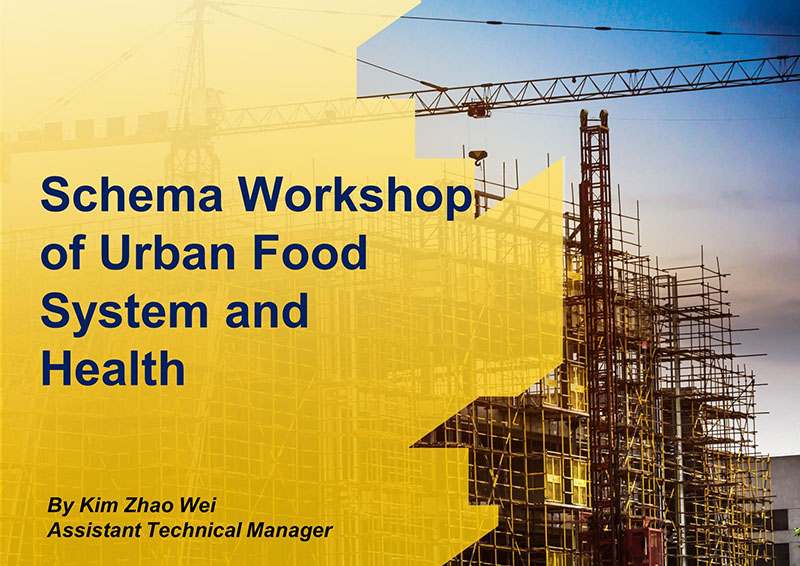Author: KIM Zhao Wei | 28 January, 2019
The living environment that we are living in is currently experiencing vast and rapid changes. In the news, we see a lot of issues like climate change, pollution, social inequality, social exclusion and more. Nonetheless, those issues are real and some of us are experiencing that and may already a victim. In the end, none of us can escape if nothing is done about it. For instance, climate change, Earth itself is not replaceable and if it is no longer habitable for human, then it means we are leading to our own extinction, which is somehow illogical. Thus, it is important that our generation needs to be well aware of the problems and take actions from now. I also believe that through spreading this awareness to other people, we can congregate and form a strong community that willing to contribute to changing the future to a better one.
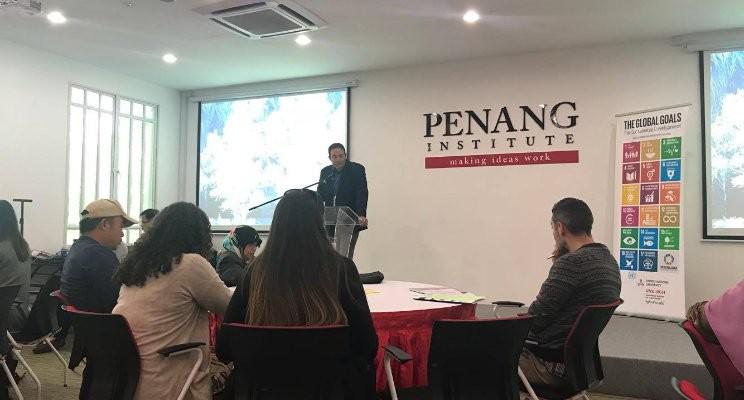
Source: Author’s Photography
I was grateful that Dr. Lee Yi Yi from United Nations University – International Institute for Global Health had invited me to be part of the Systems Thinking and Place-based Methods for Healthier Malaysian Cities (SCHEMA) Workshop. This is a joint project between the Sustainable Places Research Institute of Cardiff University and the International Institute for Global Health, funded by the prestigious foundation of Newton-Ungku Omar Fund. It was 3 days intensive workshop with sharing sessions, site visits, brainstorming and even learning sessions, which I found it to be mentally challenging. From the workshop, I learned about the food and health system of Malaysia and get to know people from different backgrounds like from the ministry, university, institutions, NGO’s and also private sectors. I myself represented the private sector, as a graduate architect to share my knowledge on urban agriculture and architecture with the participants.
There were variety of topics being discussed during the brainstorming session which I would like to summarize in point forms for the ease of communication:
- The definition of food does not end as being a commodity or a basic source of energy for the human, but it also involves in the environmental impact that is caused by agricultural activities, carbon emissions, and energy consumption from the logistic
- Eating out (meaning to eat outside), is a culture of Malaysian, especially people that live in the city. Although it provides a lot of variety, it comes with less control on the quality of food.
- Food security includes the stability of price as well. During the world food price crisis around 2007 and 2008, the price spiked and impacted countries throughout the globe.
- Breakdown a system and to see what issue nested in within and think about how to improve or reconnect the dots. It is more like a first principle thinking that a lot of elites practiced, like Elon Musk whereby the method breaks down the complex system, finds the most important factor that is jeopardizing the system and solve it.
- A good way to evaluate the quality of food is by determining the numbers of hand and machine touching the food. The lesser it is, the better the quality is. This is a method proposed by Prof. Terry Marsden from Cardiff University.
- Agriculture, especially the livestock industry contributed to the second largest greenhouse gas emissions in the globe. As the human population grows, there will be more demand for meat, hence thriving more production. This will end up putting the industry on the top greenhouse gas emission and worsen the climate change. So how are we going to solve this issue? Perhaps opting for artificial meat that may raise another ethical debate? I would rather eat artificial meat that is proven to be safe than dying because of sticking with the conventional meat production.
- In China, megacities are linked together by high-speed railways and highways, slowly congregates into a super megacity that has not existed yet. So, how are we going to feed this scale of the city?
- Is food bank enough to solve the food insecurity? Or is it a temporary solution, like a safe?
- Food is the new oil, the land is the new gold. This is becoming more and more relevant to us as we see the price of food slowly increase and the land price soared. We had transited from a food abundance era to a scarcity era. However, we still have the problem of food waste with as high as 40% and more, which is insane.
- A better educational system that touches our food production system can help in improving the situation whereby the young generation is segregated from the farm and the knowledge of Real Food.
- There was a research that studied how the local community of Malaysia eats. The fiber intake of Malaysian was very minimal. The worst is that Malaysia is now the most obese country in South East Asia with near 50% population is obese or overweight. Is it the fault of our food system? Local culture? Built environment?
- Organic food lacks certification that verifies whether the vendors are providing the nutrient value that they promised. Will this certification work and help the consumers to make a better choice?
- There is a large calories intake inequality happened throughout the world. People with less financial security may tend to have higher calories intake and end up to be obese or overweight. Does poverty relate directly to the community health condition?
- The Malaysia’s Ministry of Health is looking into the condition of the living environment as they are aware that if the built environment for the people is not designed well, it will cause the community to have a lower immune system. Besides, the future building design should be climatic resilience which has less energy consumption, especially in air conditioning. It is a known fact that the human population will increase and the need for housing will rise. With more supply, the use of air conditioning will increase as well, that will end up speeding up the climate change. For example, houses can be designed to have cross ventilation or stack effect to promote natural ventilation and cool down the building. The UN-Habitat looks into these issues and is trying to bring solutions with declarations and implementation actions.
- A good food system should be governed by the nutrition value produced for the consumers, as a balanced diet is made up of different types of nutrients with the right proportion.
- The loci for a household food insecurity consists of the location of the food source, availability, price, quality, variations and the promotion of consuming local food. We may eat a lot but we may still end up with malnutrition, as we are not taking the well-balanced nutrient diet.
- The recent flood that happened in Penang, Kedah, Perak and the East Coast had raised the issue of food security of the food for the flood victims. The secureness is justified by the availability of the food, the accessibility, the stability of supply and price and also utilization.
- Urban food system also relates to the urban environment and psychological distress level of the urbanites. In order to monitor the impact, we can utilize GIS technology to look into aspects like traffic, green space availability, the distance between farm and plate, walkability, network, land use, crime, and safety. We need to look into the physical form, natural environment and social environment as a whole to understand how the community works.
- There is a need to increase the incentive for health screening and encourage people to do so. As prevention is always better than cure, it is always better to interfere with the health problem as early as possible before it is too late. So how to encourage people to go for a health screening?
- Sustainable Development Goals has a calculation method to just how much impact had been made. The method has an amazing aspect that if the action goes again the goals, it may cancel out the positive marks and end up with neutral or negative impact.
- Promotion to embrace riverbank farming as riverbank provides different resources like a ready ecosystem, water and also the connection with the people. It may be the time for the cities to relook on how to revitalize the city by revamping its river, like how Cheonggyecheon Stream in Seoul.
- There is lesser labor involved in agricultural practice and this will affect the quality of the agricultural product due to man shortage. The production outsourcing service was introduced to solve this problem like what happened in the cocoa industry. Basically, the owner will delegate the labor work to the outsourcing service to harvest and process the produce to be sold.
- Urban agriculture is a rising trend whereby people start to bring food source back to the city. This could improve the connection between the community, food security, sustainability, and economics too. Individuals, specific communities, and schools could be part of the drivers for this initiative to work.
- Malaysian wasted 1/3 of their food which is approximately RM246 million per year. Thus, the government had set up plans, policies to handle the food waste issue, like introducing segregation of organic and non-organic waste.
- The culture of instant food consumption was highlighted as it affects the young generation the most. Most of the urbanites are used to instant food consumption due to the hectic lifestyle and have no time for hands-on cooking. So, should we start to pick up cooking again?
- Malaysia has the highest sugar and fat intake population among the Southeast Asia countries. This is a worrying statistic and people should be educated more on the consumption habit.
- An interesting idea from a local practicing doctor that prompted a question on what is the most efficient medium to pass health knowledge to the adult community, like women? Maybe hairdressers can be the answer as women will most likely communicate with hairdressers quite frequently and with the least psychological defense.
- The food policy has no innovation since long time ago, meaning to say we are still using the old horse carriage liked food system to run in this electrical vehicle era. We should revise and redefine our food policy by starting to look into growing urbanization, urban bias, city food network, trans-local alliances and method of implementation. Usually the federal government will have difficulty in implementing the policies as top-down implementation will have lower efficiency when it reaches the bottom. Thus, the government will require partners like institutions, local governments and communities to work together to build trans-local vision and exercising multi-scalar agency.
All of these points were a good starting point to think and come out with a solution to make the situation better, creating a more sustainable future. Besides, the workshop had facilitated us with System Thinking method. It is a thinking method that involves stock and flows. In a way, stocks represent accumulations of issues and challenges while flows are the output of ideas and solutions that we can think of.
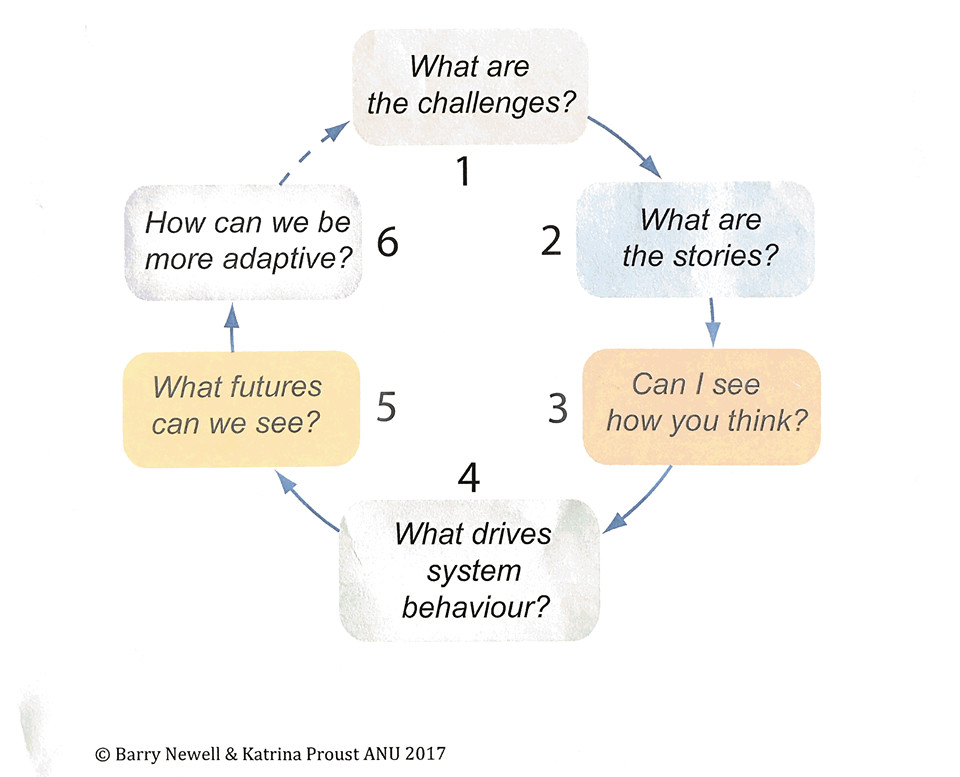
Source: Barry Newell & Katrina Proust ANU 2017, Link
In a more solid example, the mentors in the workshop introduced this methodology to help us understand what system behavior through Influence Diagrams and Casual Loop Diagrams is, or in overall a feedback diagram.
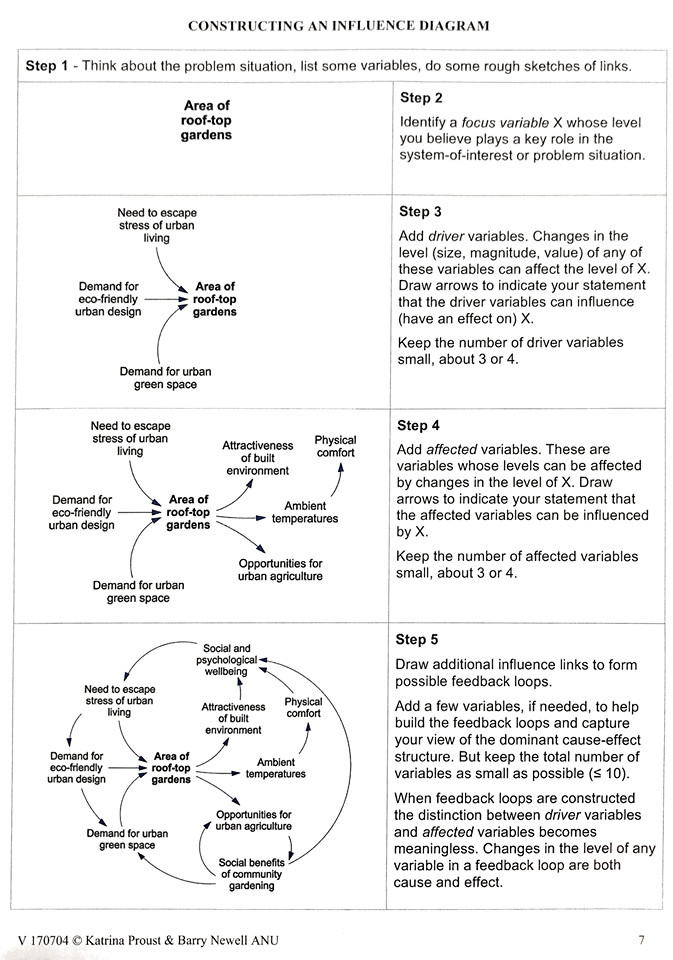
Source: Katrina Proust & Barry Newell ANU
Once we captured such thinking method, it drives our critical thinking skill and make path to a clearer, more documented thinking process. This is helpful in all levels of work and different diversification of industries. Besides, when we are working with System Thinking, we should be aware that there are several principles that enable us to use the method efficiently. For example, in martial arts, blowing a punch isn’t just as simple as grab your fist and punch as it will be just a brute force. We need to know how to stabilize ourselves through stands, how to deliver a punch by doing it quick and minimum contact duration, how to create a powerful punch through the help of momentum and so on. All these are principles behind in making a good punch, like System Thinking.

Here is how my group’s feedback loop looked like, with Dr. Ahmad Fariz from Lestari helping to hold the final masterpiece.
In conclusion, design system thinking methodology is like a compass for us to lead us through the messy thinking process when we are doing creative works. It is one great tool to utilize but not easy to adopt. However, it is worth to give it a try and make it into part of our daily life thinking tool to improve our personal lifestyle.
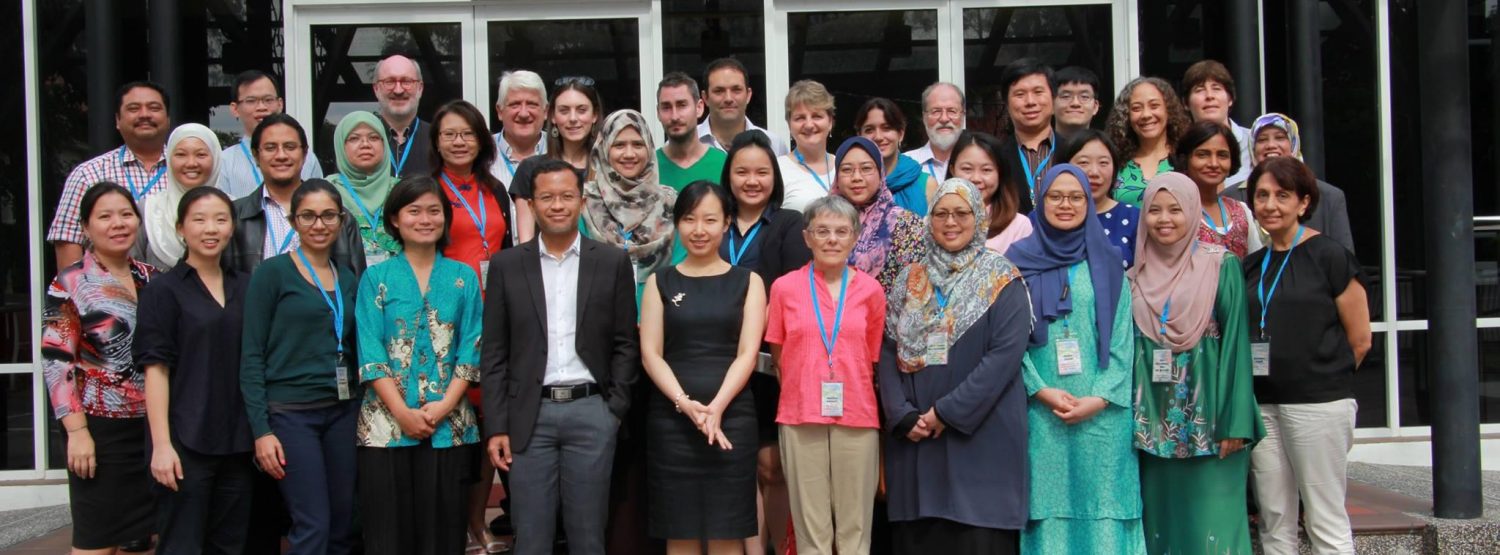
Source: Dr Yi Yi Lee’s Photography
